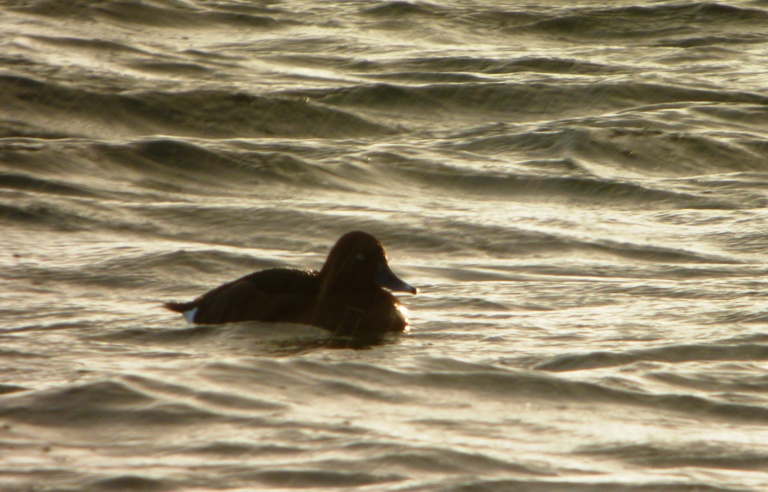| Vorige | Terug | Volgende |

| Naam: | Witoogeend / Aythya nyroca |
| Plaats: | Wessem, Koeweide |
| Datum: | 05 december 2011 |
| Fotograaf: | |
| Toegevoegd: | 05 december 2011 |
| Determinatie: | Zeker |
| Hits: | 4827 |
| Deze ad. man Witoogeend werd gisteren ontdekt door Ton Cuijpers in een groep Tafeleenden. Eindelijk weer eens een wintervogel in Limburg. In 2010 hadden we een voorjaarsgeval in de provincie maar winterende ex. zijn de laatste jaren schaars geworden in dit voormalige "stronghold" voor de soort in de winter. | |
 |
| Fraaie plaat Max! ;) |
 |
| Een goede fotograaf zal ik nooit worden, er kwam een buitje over.. |
 |
| Niet zo heel goed nieuws over zijn "neefje" de Bears Pochard via Gerard S.: Op het BirdLife forum waar jij ooit een posting deed over Baer’s Pochard zag ik zojuist deze reactie van ongeveer een maand geleden die de ernst van de situatie bevestigt: Wang Xin, Cao Lei, Lei Jinyu, Tony Fox says: February 12, 2012 at 1:31 pm Based on recent compilation and collation of counts and observations from a wide array of available information, we are deeply concerned to find a drastic decline in wintering numbers and range contraction of Baer’s Pochard. The results of the exercise have been gathered in a database and analyses have been prepared for formal reporting, but given the urgency of the situation, we feel the very pressing need to report preliminary findings here. Because of lack of consistent and regular counts from many wintering sites, it is difficult to present count data in any logical way that provides a clear indication of true population trajectory. However, it is our impression from counts and speaking directly to national experts that the species has now functionally ceased to winter in regular numbers at any site outside of mainland China as of winter 2010/11. Within China, the sum of maximum annual winter counts (November to March) from each province fell from 16,792 during 1987-1993 to 2,131 in 2002-2011. There was a marked contraction of range within China over this period, with no records from many provinces in recent years, despite increases in birdwatching activity. Clearly using maximum counts over a series of years likely over-estimates the true numbers actually present in any one year, but the relative values indicate the magnitude of the decline and the geographical contraction in range which is very evident throughout the winter quarters. The Chinese State Forest Agency and WWF-China recently coordinated coverage of winter resorts in the middle and lower Yangtze River Floodplain (now considered the core wintering area for the species) but found less than 200 Baer’s Pochard in January 2011. Perhaps far worse, a special survey by Wuhan Birdwatching Society this winter (2011/12) did not find any Baer’s Pochard at all, even at Liangzi Lake (where the survey had found c. 130 individuals last year). Birdwatchers have also been to the upper part of Wuchang Lake in Anhui this winter where Cao Lei’s group have been finding more than 200 in recent years and found none there as well. In the Baiquan wetlands, in Wuhan, where the species was often found in the past, there are only reports of poisoned swans and geese because the water levels in winter 2011/12 are so low and people can get near to the waterbirds as never before. Based on improved counts from very recent years, we fear that the global population of the species is now less than 1000 individuals and are deeply concerned that the true world total could be very much lower than this. Since we find very little information about current breeding and staging areas, there is an immediate need to better understand the breeding distribution and biology of Baer’s Pochard. Given the widespread and rapid decline, it seems unlikely that factors on all the non-breeding areas have simultaneously contributed to its demise alone, although we cannot rule out the effects very heavy mortality at a key staging site (such as hunting) where a large proportion of the population passes each year. Nevertheless, there is an urgent need to determine the food supply and conditions for the species on the last few remaining lakes used on the winter quarters to secure their sympathetic management in winter, if it is not already too late. There is no denying the very urgent need for rapid and coordinated actions to protect the Baer’s Pochard throughout its remaining range and recommend suitable re-grading of its current status as soon as possible. Zie ook de meldingen op observado: http://observado.org/soort/view/70509?from=01-01-1900&to=2012-03-15&prov=0&maand=0&rows=20&os=0 |
| Gewijzigd op: 2012-03-15 16:47:20 |






